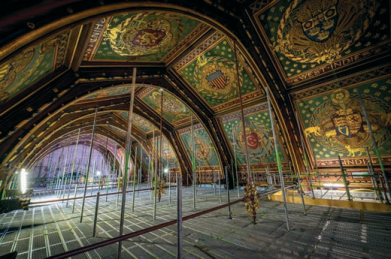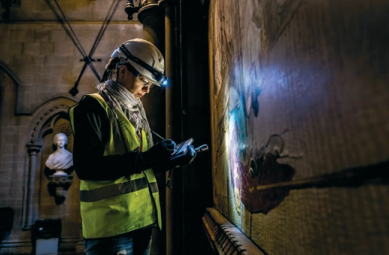Conservation work reveals town hall’s decorative glories
 (Left) Manchester Town Hall prior to commencement of the ‘Our Town Hall’ project, viewed from Albert Square; (right) The Great Hall, midway through the project, showing the Ford Madox Brown murals at low level, with protective facing tissue applied, and the decorated ceiling before conservation
(Left) Manchester Town Hall prior to commencement of the ‘Our Town Hall’ project, viewed from Albert Square; (right) The Great Hall, midway through the project, showing the Ford Madox Brown murals at low level, with protective facing tissue applied, and the decorated ceiling before conservation
Manchester Town Hall, designed by Alfred Waterhouse and constructed between 1868-1877, is a neo-Gothic, Grade One-listed masterpiece, lying at the geographical and civic heart of the city and providing a focal point for its people in times of both celebration and despair. At the centre of the Town Hall is the Great Hall, described by Ruskin as ‘the most truly magnificent Gothic apartment in Europe’. The vast chamber was designed to celebrate 19th-century Manchester’s global success in trade and commerce.
The lower walls of the Great Hall are decorated with 12 magnificent murals by Ford Madox Brown. Painted between 1879-93, the murals illustrate Manchester’s history through the lenses of Christianity, the textile industry and worldwide trade. Overhead, and to a height of 17.5 metres, is a wagon-roof ceiling richly decorated with 28 panels displaying the arms and insignia of Manchester’s principal trading partners. The decoration was created in 1876 by London-based stained-glass and mural makers Heaton, Butler and Bayne. Such incredible embellishments are a frequent gift from Victorian designers, perhaps unheeding of later generations’ obligations to preserve their masterworks. Certainly, the creators of Manchester Town Hall seemed aware of the threat posed to their work by Manchester’s damp, smoky environment: Heaton, Butler, and Bayne selected strong colours for the Great Hall ceiling in response to ‘…the great height of the roof and its semi-obscurity occasioned by the state of the atmosphere’ (Manchester Courier, 1877).
 The decoration on the Great Hall ceiling after cleaning and conservation with access scaffolding still in placeTo combat damp within the Great Hall, Madox Brown adopted the pioneering Gambier Parry wax medium spirit fresco technique for his murals: the 19th century saw a revival in the use of such wax media for interior decoration as artists searched for a paint that was water-resistant and could replicate the matte appearance of true fresco. A similar system may have been adopted for the ceiling decoration, with the Manchester Courier further stating that it ‘…is painted throughout in wax media’.
The decoration on the Great Hall ceiling after cleaning and conservation with access scaffolding still in placeTo combat damp within the Great Hall, Madox Brown adopted the pioneering Gambier Parry wax medium spirit fresco technique for his murals: the 19th century saw a revival in the use of such wax media for interior decoration as artists searched for a paint that was water-resistant and could replicate the matte appearance of true fresco. A similar system may have been adopted for the ceiling decoration, with the Manchester Courier further stating that it ‘…is painted throughout in wax media’.
Despite attempts to preserve their work, the condition of the murals and ceiling decoration in the Great Hall has been compromised by the usual threats from water ingress, salt migration, uncontrolled environmental conditions, pollution, vandalism and previous ad hoc restoration, along with the natural ageing of materials and occasional failure of the artist’s technique.
By the early 21st century the Town Hall was showing its age. In 2018 the ‘Our Town Hall’ project began, charged with the Herculean task of restoring and modernising the building and the adjacent Albert Square. The Town Hall is temporarily closed and is 60% of the way through the programmed restoration and refurbishment works. A huge variety of conservation professionals are currently employed to conserve the building and its contents, working alongside local volunteers and apprentices.
Hirst Conservation has been awarded several work packages, including architectural paint research throughout the building, stabilisation and protection of the Madox Brown murals and conservation of the decorated ceiling in the Great Hall. Hirst Conservation found the Madox Brown murals to be in sound condition, confirming that they had been well looked after. Emergency stabilisation works included consolidation of flaking paint and the application of a tissue facing to protect the paint surface from vibrations and dust while major building works were undertaken in the Town Hall.
Viewed from floor level, the decoration on the ceiling panels appeared to be in a similarly sound condition, suggesting that the difficulties inherent in accessing such a high ceiling may have discouraged harsh historic interventions, thereby preserving the original ceiling. Therefore, during Hirst’s investigations and analysis of the ceiling to underpin the methodology for its conservation, it came as a considerable surprise to find that the ceiling panels had been cleaned and overpainted at least three times between 1894 and 1969.
Each restoration or decoration phase, high in the apex of the hall, was dated and signed with the scribbled names of those personally involved.
 Conservator from Hirst Conservation surveying the Ford Madox Brown murals in the Great Hall prior to their stabilisation and protectionOur conservation team were thrilled to find these ‘time capsules’. The names ‘Heaton, Bayne and Henry Marchant, Nov 9th, 1876’ were also found scratched into the paint alongside the Latin phrase Me Facit (Made Me): a delightful discovery.
Conservator from Hirst Conservation surveying the Ford Madox Brown murals in the Great Hall prior to their stabilisation and protectionOur conservation team were thrilled to find these ‘time capsules’. The names ‘Heaton, Bayne and Henry Marchant, Nov 9th, 1876’ were also found scratched into the paint alongside the Latin phrase Me Facit (Made Me): a delightful discovery.
Analysis showed that, within years of their creation, the decorated panels had become dulled with the grime of industrialisation, prompting cycles of cleaning and overpainting which would inadvertently cause damage to the original paint and design over the ensuing century. Further damage would have been caused by water ingress and an uncontrolled internal environment conducive to salt migrations within the fabric, flaking of paint layers and inevitably more repainting.
The design of two panels was deliberately altered as Manchester’s political and commercial ties evolved: Austria became New Zealand and Prussia became South Africa. The latter panel was sheeted over in the 1980s as part of Manchester’s anti-apartheid stance. Scores of holes in the panels were found to contain air gun pellets: legend has it that a council employee used an air gun to shoot down balloons that had floated up to the ceiling during parties.
Low intervention conservation of the decorative scheme and stabilisation of its environment was agreed by Hirst Conservation and the design team to address threats to the condition of the decorative scheme, while retaining alterations, graffiti and the pellet holes as part of the ceiling’s rich narrative.
Investigation of the ceiling panels included an assessment of condition, original techniques and later interventions. Digital mapping and salt, moisture and historic paint analysis further informed a safe and effective strategy for conservation.
Paint consolidation to prevent further loss of the decorative scheme was identified as the most urgent treatment required. That was achieved using synthetic adhesives applied to areas of flaking or powdering paint, assisted by the use of locally applied heat and/or pressure.
Removal of surface dirt was carried out to improve the clarity of the schemes, ensuring the process maintained visual harmony within and between the painted panels when viewed from ground level. The methods selected were tailored to each paint type and technique present, respecting variations in the paint surface caused by deterioration. Retouching was limited to areas of loss, ignoring existing overpaints.
Extensive works to the exterior as part of the ‘Our Town Hall’ project mean that the environment of the Great Hall now presents fewer hazards to the preservation of the artworks. The building is watertight and insulated; long-term environmental monitoring installed in the Great Hall will identify extreme fluctuations in conditions that could threaten the stability of the decorative surfaces; and dirt deposition will be reduced with the exclusion of indoor pollutants such as candles.
With conservation work completed, the ceiling can now be viewed in all its polychromed glory as a celebration of Manchester’s past and present, doing our creative forbears – and the people of Manchester – proud.
For further information visit www.hirst-conservation.com














